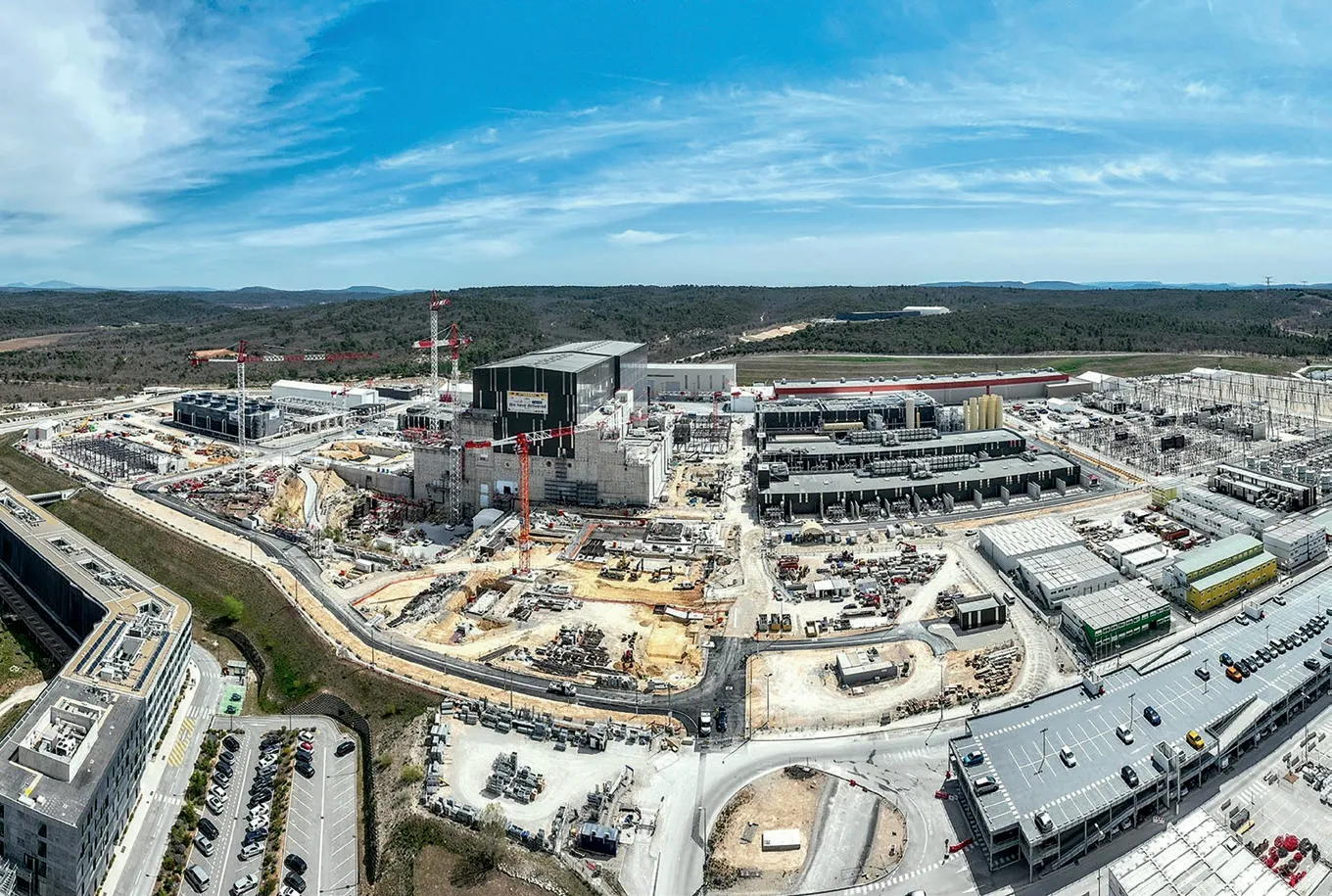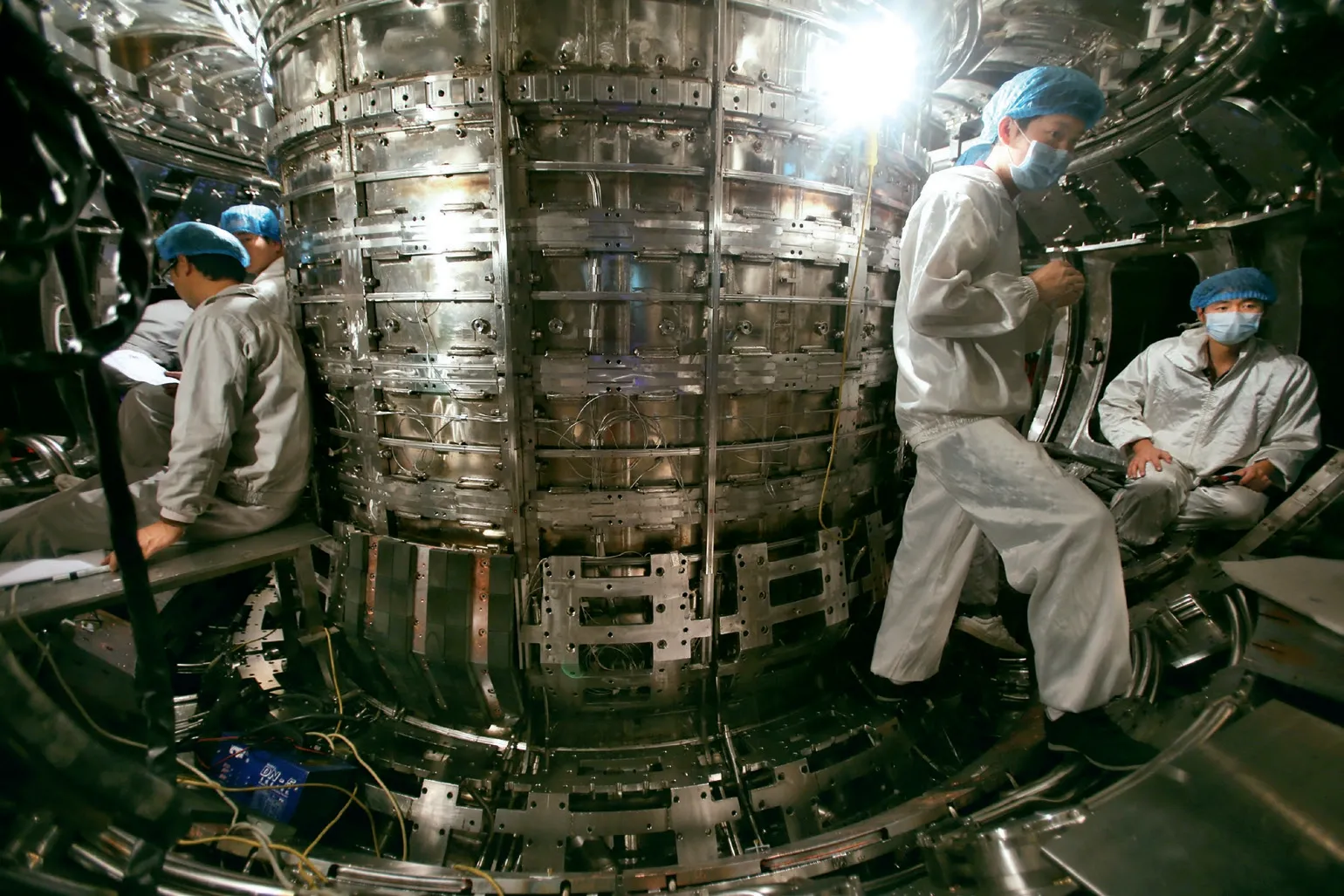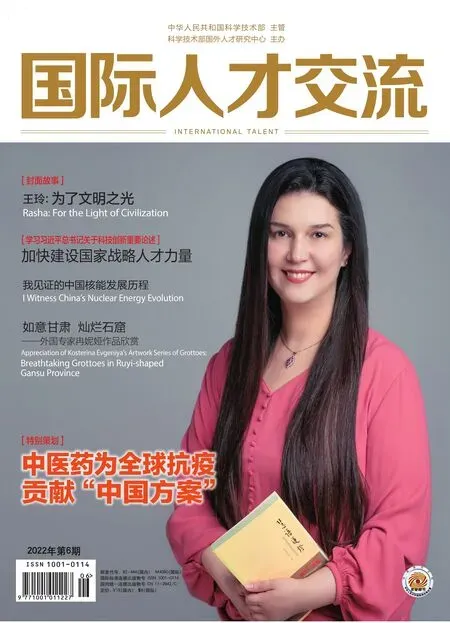我见证的中国核能发展历程
文/Bernard Bigot 译/张佳艺
在过去半个世纪中,谈及经济领域或全球科技领域的领先地位,中国的发展堪称奇迹。对于任何一个国家来说,如此迅猛地实现从发展中国家到工业化国家的蜕变都是非常了不起的;对于人口众多的中国来说,这种蜕变可谓现代历史上最伟大的成就之一。
能源在经济发展和工业化领域发挥重要作用,当然也在中国的高速发展中发挥了关键作用。我很荣幸为此尽了一点绵薄之力,特别是在用于发电的核裂变方面以及正在进行中的氢核聚变研究与开发方面。这既是双边作用即维系中法伙伴关系的一部分,也是多边作用即构建国际组织关系的一部分。在相关开发中,我拥有“前排座席”。无论作为行动者也好,还是观察者也好,我都非常珍惜其中的互动。
见证中国和平核事业稳步发展的非凡历程
理解中国的核能发展是如何初具规模的,是一定要考虑到其形成年代的。在很多人看来,关键里程碑是1985年中国第一座核电站在秦山的开工建造。但我觉得要更久远一些。早在20世纪70年代,中国就已经认真考虑发展民用核能项目了。与此同时,中法两国在科技领域的关系逐渐稳固。这或许可以追溯到1973年法国总统乔治·蓬皮杜首次访华。
从某种意义上说,法国同中国的关系从早期起就呈现这种模式,或者说特点。中国渴望获得法国已有的先进技术,使自身成为一个合理的出口市场和发展中国家的合作伙伴。在核能领域,这聚焦于中国稳步掌握和平利用核能的全方位能力,拥有质量和安全方面的最高标准和有力监管制度。随着时间的推移,这将顺理成章地推动中国提高技术能力与国内产能,最终建立起中国大规模的核工人队伍、部件制造能力和自给自足的核工业。
法国很快就意识到了与拥有巨大潜力的中国长期合作的好处与机遇。1982年,中国核工业部与法国原子能和替代能源委员会签订的“中法和平利用核能合作议定书”正式生效。该议定书在随后几十年的持久效力印证了它启动的实质性的伙伴关系。我很欣慰,回顾我于2009年到2015年担任法国原子能和替代能源委员会主席和首席执行官的这段时间,这一协议不断更新。随后,2019年3月,习近平主席访法期间签署了第十三份“中法和平利用核能合作议定书”。议定书迄今已有40年的历史,且仍在蓬勃发展。
在首次签署这一基本议定书后不久,1983年签署了第二份重在实用性的“核电合作备忘录”。借此,法国同意与位于广东的电力供应商中国广核集团合作,并提供四个900兆瓦的压水反应堆,在大亚湾建造两个机组,在岭澳建造另外两个机组。两项合作分别于1993年和1994年开始商业运行,这也是接下来许多合作的开始。
显然,中国从一开始就有合乎情理的雄心壮志,尽可能多地向全球的合作伙伴学习,从而完善自己“本土”的核电技术与能力。因此,除法国的法马通压水堆设计之外,中国同时寻找其他合作伙伴也就不足为奇了。第一批投放到中国的加拿大CANDU反应堆于2002年落地,几年后,俄罗斯VVER反应堆也在中国投入运行。这两个反应堆均是与法国电力公司在台山建造的,并在2018年和2019年正式开始运行。
有了这些不断积累的知识和经验,中国政府在2014年委托中国核工业集团开发出第一个完全由中国设计的第三代反应堆——“中国龙”,即华龙一号或HPR-1000。这一设计是多部门合作的结果,涉及17所中国大学和研究机构、58家国有企业和140多家私营公司,以确保所有核心部件都能在中国制造。作为一家中国企业,加之很大程度上源于法国的技术合作,华龙公司现在已经在中国的核电战略中占据了应有的地位。
就个人而言,我怀着喜悦与钦佩的心情见证了中国和平核事业稳步发展的这一非凡历程。早期,当我被要求带领由法国相关政府机构和法国电力公司、阿海珐等公司组成的法国代表团与中国同行互动与合作时,中国的和平核事业就已经在稳步发展了。在我担任法国驻国际原子能机构的理事期间,多边合作形式也在践行着。作为一个可靠的合作伙伴,中国自然可以稳步崛起。
当然,这种惊人的发展绝不仅限于核能。电力经常被称为经济增长的载体。几十年来,我多次访问北京和中国其他许多城市,没有比我的所见所闻更好的例子了。中国的城市天际线、现代机场、高铁服务和许多其他技术领域的惊人演变每年都在继续,每进行一次新的访问都会发现一次惊人发展。在可观的投资和合作的支持下,中国这个“发展中国家伙伴”出现了,跻身成为全球主导力量的一员。
因此,中国核电项目的现状既是中国整体现代化和科技进步的反映,也是其支撑力量。中国有52台机组投入使用,另有20台机组正在建设中。中国无疑是全球核电扩张最活跃的国家之一。2020年,中国的核电产量首次超越法国(仅次于美国)。如果继续每年建造6—8座新核电站的计划,中国的核电装机容量将于2035年达到150GWe。
令我特别欣慰的是,尽管中国国内产能出现了前所未有的增长,但中法数十年合作所奠定的基础仍继续为中国的法国中小型企业发挥作用。以法国电力公司为中心的法中电力协会的大约90个联合成员,将继续为中国核电行业的持续发展和运营提供服务和维护,并通常通过合资企业为这些法国公司大幅拓展市场。这一系列持续稳定的关系令人信服其合作和互补增长的互利性。
除了核电站,中法合作还延伸到整个核燃料循环的广泛领域
中国的下一步按理来说就是出口。首批完全“中国制造”的华龙反应堆已在福清和凤城港投入使用,另有六个机组授权在漳州、惠州和昌江建造。与此同时,三个国际项目也在稳步推进:在英国,监管机构于2022年2月通过了HPR-1000反应堆的通用设计评估;在巴基斯坦,两个HPR-1000反应堆已经在卡拉奇成功安装,最近的一个于2022年3月并网,另有三个机组尚在规划中;在阿根廷,加拿大和中国正在共同制订计划,拟建造一个CANDU和一个华龙机组。
其他国际项目无疑也将随之而来,例如在巴西、捷克共和国和肯尼亚定期报告的讨论则正在进行中。中国有条不紊地推进标准化和成本效益,同时严格恪守安全和质量标准,这为其作为先进技术可靠出口国的声誉增添了可信度。中国核工业集团拟创建一个新反应堆设计,即华龙二号,使其成本大大降低,并将建造时间从5年缩短为4年。这大概会引起国际社会的兴趣。
除核电站外,中法合作还延伸到整个核燃料循环的广泛研发领域,尤其强调法国在后处理和废物处理方面的先进技术。在这一合作领域,历史也很重要。20世纪90年代,当我在法国研究部担任科技团团长(1993—1996年)、研究与技术总干事(1996—1997年)和研究部副主任(1998—2000年)等不同职务时,如前文所述,中国支持法国电力公司合资企业和法国核工业在中国的部署,这在很大程度上是通过法国原子能和替代能源委员会作为培训行动来实施的。
随着中国的核科学与核能力不可阻挡的发展,未来20年的重点也相应转移了。首先是设计和建造一个100%本土化的中国核电站,然后是更广泛的多样化研发。2018年,当埃马纽埃尔·马克龙总统对北京进行国事访问时,中国与阿海珐签署了一份重要的商业协议备忘录,意在建立一个核燃料后处理厂。这代表了中国的一个战略选择:与美国和其他大型核电用户不同,中国释放出采用法国模式的信号,即对废旧核燃料进行后处理,回收铀和钚以制造“混合氧化物”燃料,并对玻璃化裂变产物废物进行地质掩埋。这种对废旧核燃料的再处理减少了中国对进口铀的依赖,并延长了整个核电前景的寿命。

国际热核聚变实验堆(ITER)计划法国总部(图片来源:ITER官网)

科研人员在升级全超导托卡马克核聚变实验装置(新华社记者金立旺 摄)
同样,中国的研发已经扩展到部署快中子反应堆和第四代反应堆,正在进行着各种类型的原型和演示工作:高温气冷反应堆、使用钍作为燃料的熔盐反应堆、小型模块化核电站、铅铋反应堆以及粒子加速器相关的亚临界反应堆。总体而言,这些项目中的任何一个都可能不会被纳入长期愿景,然而这些项目的庞大规模说明了中国通过伙伴关系和国内研究而战略性积累的专业知识,正在使中国摇身变为21世纪杰出的核电领导者。
国际热核聚变实验堆为全人类谋福利
最后,我谈谈中国作为国际伙伴在全球努力中恪守氢聚变承诺的成长。核聚变能源像裂变一样,是一个核过程,但物理学上是完全不同的。太阳和所有恒星是宇宙中最丰富的能源,也是地球上所有光和热的来源。氢聚变是太阳和所有恒星的核心动力,提供了承载生命的环境。核聚变能源有许多优点,为子孙后代提供了安全、环保和几乎无限的能源。然而,事实证明,氢聚变能源的可控生产是一项具有挑战性的工作。
在太阳的核心,由于极端的引力迫使氢核融合,核聚变产生了。因这种引力无法在地球上复制,科学家和工程师已经研究了60多年利用核聚变能源的替代方法。最有希望的方法是磁约束核聚变。在这种方法中,低密度核聚变等离子体在一个被称为托卡马克的圆环形金属室中产生,加热到氢核达到发生核聚变所需的150度左右,反应会被一个精确成形的磁场控制和限制。
领先的国际氢核聚变的研究合作是位于法国南部的国际热核聚变实验堆(ITER)计划。ITER是1985年由美国总统罗纳德·里根和苏共中央总书记米哈伊尔·戈尔巴乔夫所构想的一个旨在“为全人类谋福利”的项目。在随后的几十年里,中国、欧洲、印度、日本和韩国加入了。该计划已被视为每个相关成员国的国家核聚变研发路线图的汇聚点。
在ITER计划中,中国作为一个稳定、可靠的合作伙伴和领导者所发挥的作用在计划的采购战略中得到了最好的诠释。欧洲作为东道主成员,出资约46%,包括中国在内的其他成员各出资9%。但是这些贡献并非以现金形式支付的,相反,每个成员的贡献中约有90%是以“实物”即组件的形式提供的。组成该计划的部件超过100万个,加上相关的支持系统和服务,其结果错综复杂:集中设计、在三大洲的分布式制造、运输和存储物流,以及前所未有的合作。这使得每个贡献都能及时投入测试中,并根据需要进行调节,并入该计划的机器中。
根据设计,这种安排使每个成员国都能并行开发需要国家与国际科学进步和工程创新的各式首创部件。中国已为ITER提供了各种关键部件:所谓的馈电装置为巨型超导磁体提供电力和低温,更精细的“校正线圈”使操作人员能够“微调”磁场的精确形状,数百个部件用于提供无功补偿和电力转换以支持托卡马克运行。
2020年6月,在新冠肺炎疫情发生后不久,ITER组装阶段的一个早期里程碑得以实现。当时的中国尽管面临许多方面的挑战,最终还是成功交付了6号环形场线圈。这是一场从中国合肥到普罗旺斯ITER场址的海陆之旅。这个直径10米、重达400多吨的环形超导磁体是根据与ITER欧洲国内机构的安排在中国制造的,在多个层面上代表了一种前所未有的突破。在低温测试成功后,它成为2021年4月在ITER安装的第一个磁铁。
至关重要的是,中国在参与ITER项目的同时,国内的核聚变研发项目也日益成熟。在20世纪90年代中期,中国与俄罗斯合作建造了第一台超导核聚变装置,即“合肥超环”(HT-7)。该装置被2006年开始运行的全超导托卡马克核聚变实验装置(EAST)取代。由合肥物质科学研究院代表中国科学院运行的EAST继续为全球聚变研发事业作出重要贡献,最近创造了1000秒持续脉冲的纪录。
除EAST外,中国还在成都的西南物理研究所运行HL-2M装置,在武汉的华中科技大学运行J-TEXT装置。加上从ITER合作中获得的知识,这三个聚变实验装置的国内经验促成了设想中的中国聚变工程试验堆的设计。这是一个类似于ITER的装置,旨在促成中国第一个商业聚变电站的开发。
与核裂变发电一样,中国对核聚变研发的承诺一直遵循着合作伙伴关系、国内产力增强和进军领导者的模式。在2017年阿斯塔纳世界博览会上,习近平主席和其他全球领导人参观了以裂变和核聚变能源的最先进技术为特色的中国展览,我对此印象深刻。当ITER理事会主席,也是我的老友和同事罗德隆,给我发来一段视频,播放习近平主席同中国高级领导人们阐述核聚变的好处时,我又回想起了这件事。
2019年9月,在中华人民共和国成立70周年前夕,我受邀到北京接受中国政府友谊奖。当站在人民大会堂里,在刘鹤副总理主持的仪式上,我被厚重的历史征服,被几十年来中法伙伴关系的显赫成就征服,被有幸能够在两国之间这种前所未有的关系发展中发挥作用征服。
最令人难忘的是2020年7月,在疫情危机之中,中国对核聚变和ITER项目的承诺再次得到强化。ITER庆祝了其重大工程的安装与启动。在马克龙总统主持的仪式上,来自ITER成员国的七位国家元首和多位部长发表了讲话,其中包括习近平主席。他们重申了对氢核聚变共同愿景的承诺。
当中国科技部部长王志刚宣读习近平主席的贺信时,合作的力量以及中国作为合作伙伴的可靠愿景再次得到印证。“科学无国界,创新无止境。国际科技合作对于赢得人类面临的全球性挑战具有重要意义……中方愿同各方合力推进全球科技创新,为增进各国人民的福祉、实现全球可持续发展不断作出新贡献。”
诚然,这是我们对未来所持有的共同愿景。
The evolution of the People’s Republic of China over the last halfcentury-both economically and technologically as a global leader-is rightly regarded as a miracle. It would be remarkable for any nation to progress so quickly from a developing country to a fully industrialized status, but this occurrence in the world’s most populous country has been one of the most significant achievements in modern history.
Energy plays a crucial role in economic development and industrialization, and energy has, of course, played a critical role in China’s advancement. It has been my great privilege to play a small role in this aspect, particularly in nuclear fission for electric power generation and ongoing research and development in hydrogen fusion-both bilaterally, as part of France-China partnerships and part of multilateral and global bodies. One might say I have had a “front-row seat” to some of these developments, and I cherished these interactions as both an actor and an observer.
Watch the remarkable saga of steady growth in China’s peaceful nuclear journey
It is crucial to consider the formative years in order to understand how China’s nuclear energy evolution took shape. Many consider the start of the construction of the first Chinese nuclear power plant in Qinshan in 1985 a watershed moment. But I would look further: as far back as the 1970s, China had been giving serious consideration to developing a civil nuclear power program. Parallel to this, the Franco-Chinese relationship in science and technology had begun to take hold, possibly as a result of French President Georges Pompidou’s first visit to China in 1973.
From those early days, a pattern and a philosophy emerged that had characterized France’s relationship with China in some ways ever since. China was eager to acquire the advanced technology that France already possessed, making China a natural export market and developing country partner. In the case of nuclear energy, this necessitated a careful focus on building China’s full capacity, strategically andsteadily, to achieve a strong, peaceful nuclear regime with the highest standards of quality and safety, including a robust regulatory authority. Over time, this would logically lead to China’s acquiring more and more know-how, domestic capability and eventually to the establishment of China’s extensive nuclear workforce, component manufacturing capability, and self-sustaining nuclear industry.
France quickly understood the benefits and opportunities of having China as a long-term partnership with its massive potential. The“Cooperation Agreement between the French Alternative Energies and Atomic Energy Commission (CEA) and the Chinese Ministry of Nuclear Industry in the field of the use of peaceful atomic energy” was signed into force in 1982. The long-term viability of this agreement attests to the substantive partnership established. I am pleased to recall that this agreement was continuously renewed during my tenure as Chairman and CEO of the CEA, from 2009 through 2015, and with the signing of the 13th CEA-CAEA protocol during President Xi Jinping’s state visit to France in March 2019, the agreement-now 40 years oldcontinues to thrive.
In 1983, not long after the first signature on this fundamental agreement, a second, more practical “Memorandum of nuclear power cooperation” was signed. France agreed to provide four 900 megawatt pressurized water reactors (PWRs), collaborating with the Guangdongbased electricity provider CGNPG (China Guangdong Nuclear Power Group) to build two units at Daya Bay and two more at Ling Ao. This collaboration, which resulted in the beginning of commercial operations in 1993 and 1994, would be the first of many.
Clearly, China’s logical ambition has always been to learn as much as possible from its global partners in order to develop its own “homegrown” nuclear power technology and capacity. With that in mind, it was not surprising that China sought out other collaborators in addition to the French Framatome PWR designs. The first Chinese-based Canadian CANDU designs arrived in 2002, followed by Russian VVER reactors coming into operation in China a few years later. More recently, this diversified approach has led to the construction in China of the first two French-designed European Pressurized-Water Reactors (EPRs),developed at the Taishan site with Electricité de France (EDF) and beginning operation in 2018 and 2019.
With this ever-growing body of knowledge and experience, it was no surprise when the Chinese government, in 2014, tasked the Chinese National Nuclear Corporation (CNNC). And the re-named China General Nuclear Power Group (CGN) with developing the first fully Chinesedesigned generation III reactor: the “Chinese dragon,” Hualong-1 or HPR-1000. To ensure that all core components could be manufactured in China, 17 Chinese universities and research institutes, 58 state-owned enterprises, and more than 140 private companies collaborated to create this design. Hualong, which is entirely Chinese but owes a great deal to French technological collaboration, has now taken its rightful place at the heart of China’s nuclear power strategy and forecast for the future.
From a personal standpoint, I have watched this remarkable saga ofsteady growth in China’s peaceful nuclear journey with pleasure and admiration. Previously, I was asked to lead French delegations, which included relevant French governmental agencies and companies such as EDF and Areva, to interact and collaborate with our Chinese counterparts. It also took the form of multilateral collaborations in my capacity as the French governor of the International Atomic Energy Agency(IAEA), where China’s steady emergence as a reliable partner was also consistently evident.
Of course, nuclear power was not the only source of rapid growth.Electricity is frequently referred to as the engine of economic growth,and I can think of no better example than what I witnessed in making repeated visits to Beijing and many other cities throughout China over the years. The stunning evolution of China’s urban skylines, modern airports, high-speed rail service, and many other technological sectors continued every year with each new visit. The “developing country partner,” bolstered by sound investment and collaboration, emerged to take its place as a dominant global power.
China’s nuclear power program’s current state is both a reflection and a supporting element of China’s overall modernization and scientific and technological advancement. It is by far the most active country globally in nuclear power expansion, with 52 units (54 GWe) in service and 20 more under construction. China will surpass France in nuclear-generated electricity for the first time in 2020 (second only to the United States).If plans continue to construct 6-8 new nuclear power plants per year through 2035, China’s installed nuclear-generated electricity capacity will reach 150 GWe.
It is especially pleasing for me that, despite this unprecedented growth in China’s domestic capacity, the groundwork laid over decades of Franco-Chinese cooperation continues to provide a role in China for French small and medium-sized enterprises. Approximately 90 federated members of the PFCE-the Association of French-Chinese Electricity Partners, centered on EDF-continue to provide services and maintenance for the ongoing development and operation of the Chinese nuclear power industry, frequently through joint ventures that significantly expand the markets for these French companies. This collection of ongoing relationships compellingly exemplifies the mutual benefit of collaboration and complementary growth.
Aside from nuclear power plants, Franco-Chinese cooperation has also expanded to a broad range of R&D across the nuclear fuel cycle
The next step for China, logically, is export. The initial series of fully“Made in China” Hualong reactors were put in place in Fuqing and Fengchenggang, with six more units authorized by the Chinese regulator for construction at Zhangzhou, Huizhou, and Changjiang. But in parallel, three international projects have steadily advanced: in the United Kingdom, where the regulator passed the Generic Design Assessment for the HPR-1000 reactor in February 2022; in Pakistan,where two HPR-1000s have been successfully installed at Karachithe latest connecting to the grid in March 2022-and three more unitsare planned; and in Argentina, where Canada and China are working jointly on plans to construct one CANDU and one Hualong unit.
Other international projects will undoubtedly follow, with periodic ongoing discussion reports, for example, in Brazil, the Czech Republic,and Kenya. While rigorously adhering to safety and quality standards,China’s systematic approach to standardization and cost efficiency adds credibility to its reputation as a reliable exporter of advanced technology. The intention of CNNC to create a follow-on reactor design,Hualong-2, with substantially reduced cost and a reduction in build time from 5 years to 4, will be likely to expand international interest.
Aside from nuclear power plants, Franco-Chinese cooperation has also expanded to a broad range of R&D across the nuclear fuel cycle,emphasizing France’s unrivaled expertise in reprocessing and waste treatment. History is essential in this area of collaboration as well.Partnership with China was largely implemented through CEA as a training activity, supporting the deployment of EDF joint ventures and the French nuclear industry in China, as noted above, in the 1990s,when I was serving in various roles in the French Ministry of Research as Head of the Scientific and Technical Mission (1993-1996), Director-General of Research and Technology (1996-1997), and Deputy Director for Research (1998 to 2000).
However, as China’s nuclear science and capacity grew inevitably, the focus would be shifted over the next two decades -first to designing and constructing a 100% Chinese atomic plant and then to more broadly diversified research and development. When President Emmanuel Macron paid a state visit to Beijing in 2018, he signed a critical memorandum of a commercial agreement with Areva to establish a nuclear fuel reprocessing plant in China. This was a deliberate strategic choice on the part of China: unlike the United States and other major nuclear power users, China was signaling its adoption of the French model,in which spent nuclear fuel would be reprocessed to recover uranium and plutonium for use in the manufacture of “mixed oxide” (MOX)fuels, with vitrified fission product wastes being geologically buried.This reprocessing of used nuclear fuel reduces China’s dependency on uranium imports and extends the lifetime of the overall nuclear power outlook.
Similarly, China’s R&D has expanded to include the deployment of fast neutron reactors (FNRs) and “fourth-generation” reactors, with ongoing work on prototypes and demonstrations of various types, including high-temperature gas-cooled reactors, molten salt reactors using thorium as fuel, small modular nuclear plants, a lead-bismuth reactor, and a subcritical reactor linked to a particle accelerator. Taken as a whole, it is unlikely that all of the projects will be included in the long-term vision;however, the sheer number of projects demonstrates the extent to which Chinese expertise, accumulated strategically through partnerships and domestic research, is transforming China into the preeminent nuclear power leader of the 21st century.
ITER: for the benefit of all mankind
Finally, let me turn to China’s growth as an international partner in the global effort to bring the promise of hydrogen fusion to reality. Fusion energy is a nuclear process, like fission, but the physics is completely different. Hydrogen fusion is the power at the heart of our Sun and all the stars-the most abundant energy source in the universe-and the source of all light and heat on Earth, which provides the environment that supports life. Fusion energy has numerous advantages, including the promise of safe, environmentally friendly, and virtually limitless energy for future generations. However, the controlled production of hydrogen fusion power has proved to be a challenging endeavor.Fusion occurs at the core of the Sun due to extreme gravitation, which forces hydrogen nuclei to fuse. Because this gravitational force cannot be replicated on Earth, scientists and engineers have been working on alternative methods of harnessing fusion energy for more than six decades. The most promising method is magnetic confinement fusion,in which a low-density fusion plasma is created in a doughnut-shaped metal chamber called a Tokamak, heated to approximately 150 degrees;the temperature at which hydrogen nuclei reach the velocities needed for fusion to occur. And the reaction is controlled and confined by a precisely shaped magnetic field.
The leading international research collaboration for hydrogen fusion is the ITER project, located in the south of France. ITER was conceived in 1985 by U.S. President Ronald Reagan and Soviet Secretary Mikhail Gorbachev as a project that would exist “for the benefit of all mankind.”In the decades that followed, five additional Members joined-China,Europe, India, Japan, and Korea-and the project has become the convergence point on the national fusion R&D roadmaps of each of the Members involved.
China’s role as a steady, reliable partner and leader in the ITER project is best understood in the context of ITER’s procurement strategy. As the host Member, Europe contributes about 46% of the project, with each Member, including China, contributing 9% each. However, these contributions are not made in cash; instead, approximately 90% of each Member’s contribution is made “in kind,” in the form of components. With over one million components comprising the ITER Tokamak, as well as associated support systems and services, the result is a complex arrangement of centralized design, distributed manufacturing across three continents, logistics for transportation and storage, and unprecedented collaboration to ensure that each contribution arrives on time to be tested,conditioned as necessary, and integrated into the ITER machine.
By design, this arrangement allows each Member in parallel to develop a wide range of unique components that demand national and international scientific advances and engineering innovations. China supplies a wide range of critical components for ITER under the supervision of the Chinese domestic agency: the so-called feeders, magnets that deliver the electricity and cryogenics to power ITER’s massive superconducting magnets; the more delicate “correction coils,” magnets that allow operators to “fine-tune” the precise shape of ITER’s magnetic fields; and hundreds of components designed to provide reactive power compensation and electrical conversion to support the experiment.
An early milestone in the ITER Assembly Phase was achieved in June 2020, shortly after the onset of the Covid-19 pandemic, when China successfully delivered Poloidal Field Coil #6, a journey over land and sea from Hefei, China, to the ITER site in Provence, despite many challenges. This ring-shaped superconducting magnet, ten meters in diameter and weighing more than 400 tonnes, was manufactured in China under an agreement with ITER’s European domestic agency and represented the first-of-its-kind breakthrough on multiple levels. After successful cryogenic temperature tests, it was chosen as the first magnet to be installed at ITER in April 2021.
Critically, China’s participation in ITER has been matched by an increasingly sophisticated domestic fusion research and development program.In the mid-1990s, China built its first superconducting fusion device, Hefei-Tokamak 7, or HT-7, and collaborated with Russia. This device was replaced by the Experimental Advanced Superconducting Tokamak, or EAST, which went into operation in 2006. Operated by the Hefei Institutes of Physical Science on behalf of the Chinese Academy of Sciences, EAST has continued to make significant contributions to the global fusion R&D enterprise, most recently setting a record for a 1000-second sustained pulse.
Aside from EAST, China also operates the HL-2M tokamak at the Southwestern Institute of Physics in Chengdu and the J-TEXT device at the Huazhong University of Science and Technology in Wuhan. Combined with the knowledge gained from the ITER collaboration, the domestic experience from these three fusion experimental devices has led to the design of the envisioned China Fusion Engineering Test Reactor (CFETR),an ITER-like device intended to lead to the development of the first commercial Chinese fusion plants.
China’s commitment to fusion R&D has followed the pattern of its commitment to nuclear fission power: collaborative partnership, expansion of domestic capability, and emergence as a leader. This was clearly demonstrated to me at the World EXPO in Astana in 2017 when President Xi Jinping and other global leaders toured the Chinese exhibition, which featured state-of-the-art fission and fusion power demonstration. I was reminded again when the Chair of the ITER Council, my long-time friend, and colleague Luo Delong, sent me a video showing President Xi explaining the benefits of fusion to a group of senior Chinese leaders.
I was also deeply honoured in September 2019 when I was invited to Beijing to receive the Friendship Award on the eve of the People’s Republic of China’s 70th anniversary. Standing in the Great Hall of the People for a ceremony hosted by Vice Premier Liu He, I was overcome by the sense of history, by the remarkable fruit of our decades-long Franco-Chinese partnership. It also serves as a reminder of what a privilege it has been to play a small role in this unprecedented relationship between our two countries.
The most memorable confirmation of China’s commitment to fusion and the ITER project came nearly one year later, in July 2020, when, in midst of the pandemic crisis, ITER celebrated its Start of the Assembly Phase. During a ceremony hosted by President Macron, seven Heads of State and multiple ministers from ITER Member countries issued statements, including President Xi,reaffirming their commitment to a shared vision of hydrogen fusion.
As Minister of Science and Technology Wang Zhigang read the words of President Xi, it was yet another testament to the power of collaboration and China’s reliable vision as a partner: “Science is not bound by national borders, and innovation is a never-ending endeavour. International Science and technology cooperation is critical to humanity’s response to global challenges... Let us work together to promote science, technology, and innovation across the globe and make new contributions to the betterment of lives in all countries and long-term development of the entire world.”
Honestly, this is indeed a shared vision of the future to which we can aspire.

